Business
What is the EU’s new border system EES – and how does it work?
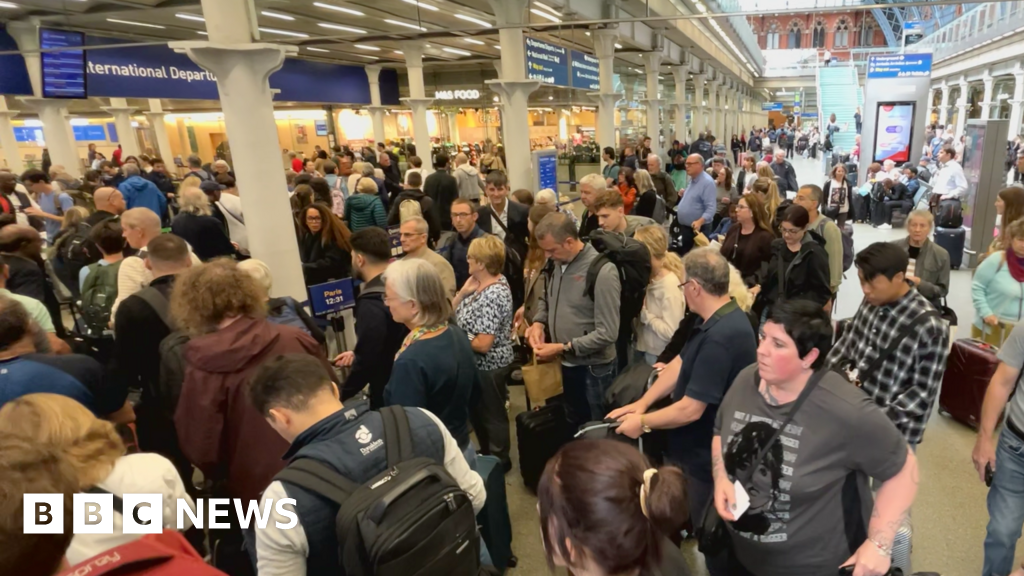
Katy AustinTransport correspondent
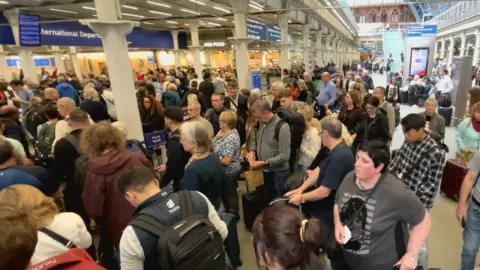 BBC
BBCThe next time you travel from the UK to Europe, you might notice some changes.
The EU’s much-delayed new digital border system, the Entry/Exit System or EES, will be gradually introduced this autumn.
The system is meant to strengthen security and ultimately make travel smoother, but there are concerns it could lead to long queues when people first register.
What is EES and where is it being introduced?
EES is a digital system designed to keep track of when non-EU citizens enter and leave the Schengen Area.
This covers 29 European countries – mainly in the EU – which member citizens can travel across freely without border controls.
It includes many popular destinations for UK travellers, such as France, Spain, Portugal, Italy and Greece.
EES will eventually replace the current system which requires individual passports to be checked and stamped by a border officer.
When will EES start?
After being postponed several times, the European Commission confirmed in July that EES will begin on 12 October. It will be phased in gradually over six months.
At Dover, coach passengers will start using the new system on 12 October, followed by other tourist traffic on 1 November.
At Eurostar terminals, EES will be introduced more gradually.
Only a small number of business travellers will be invited to use the new system from 12 October. More passengers will be directed to use it over subsequent months.
Eurotunnel, which runs vehicle shuttles through the Channel Tunnel, is also expecting to introduce EES in stages from 12 October.
EES should be active at every Schengen border crossing point in all 29 participating countries by 10 April 2026.
What will passengers have to do under EES?
The first time they use the new system, people from most non-EU countries – including the UK – will have to register biometric information while having their passport scanned.
This may be done with a border officer, depending on where people travel to.
Flight passengers will register when they arrive at their destination airport.
But registration will be done as you leave the UK if you are crossing the English Channel by ferry from the port of Dover, taking the Eurotunnel shuttle to France, or getting the Eurostar train.
At these places, passengers will have to follow the instructions on kiosks – automated machines installed in dedicated areas.
The machines will scan each passport, then take fingerprints and a photo.
Children under 12 won’t have to provide fingerprints. Staff should be on hand to help.
The machine’s screen will also present travellers with four questions about their trip, such as confirming where they will be staying and that they have enough money.
However, at Eurotunnel, those questions will be asked by border officers instead, and only on a discretionary basis.
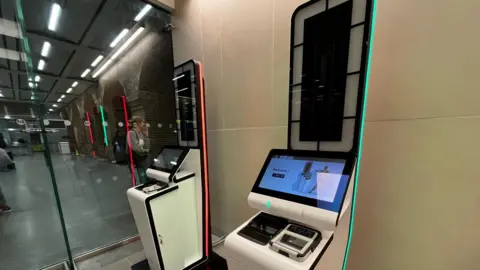
Eurostar has installed 49 EES kiosks in three areas around its London St Pancras terminal. Passengers will use them before presenting their ticket at the departures area.
But it says all passports will continue to be stamped manually until EES is fully rolled out in 2026.
Eurotunnel has installed more than a hundred kiosks at each side of the Channel.
Customers who are travelling in cars will be directed to drive up to a kiosk bearing their registration number, and provide their biometric information there. Coach passengers will go through the process with a border officer.
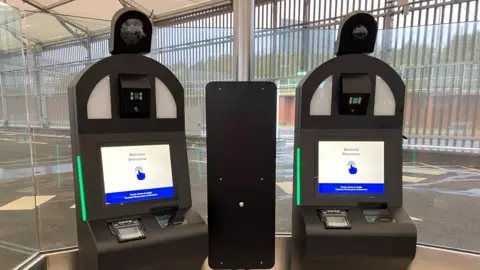
A mobile phone app has been developed to enable passengers to do part of the process before reaching the border. However, this won’t be widely used when EES is first introduced.
The EES registration will be valid for three years, with the details verified on each trip during that period.
What are the concerns about the introduction of EES?
Concerns have repeatedly been raised that the extra couple of minutes it takes for each traveller to complete the registration process could lead to big queues, particularly at space-constrained Dover.
However, bosses at cross-Channel travel hubs hope that the decision to introduce EES gradually, instead of with a “big bang” start, will reduce the risk of disruption.
The port of Dover previously planned to give ferry passengers tablet devices so they could register inside their vehicles, but will now use kiosks similar to those at Eurostar and Eurotunnel. The port has reclaimed some land from the sea to create more space for processing.
During the initial transition period, the port will be able to temporarily stand down EES if queues get too long, and revert to manual passport stamping.
Eurotunnel chief executive Yann Leriche says there will be no “chaos” or queues at the Channel tunnel, insisting his company has done extensive modelling and is fully prepared.
Similarly, Eurostar hopes its decision to limit EES initially to some business travellers before expanding its use will help to prevent queues.
What is ETIAS and when is that coming?
The EU is also introducing a new visa waiver system linked to passports called the European Travel Information and Authorisation System (ETIAS), which will build on the EES.
Citizens of non-EU countries who don’t need a visa to enter the EU – including people from the UK – will be able to apply online for authorisation before they travel.
ETIAS isn’t due to start until the end of 2026, but the final date has not yet been confirmed.
It will cost €20 (£17.47) per application, and will be valid for three years.
People aged under 18 and over 70 will need to apply, but won’t have to pay.
Business
Rachel Reeves suggests family benefit limits will be lifted
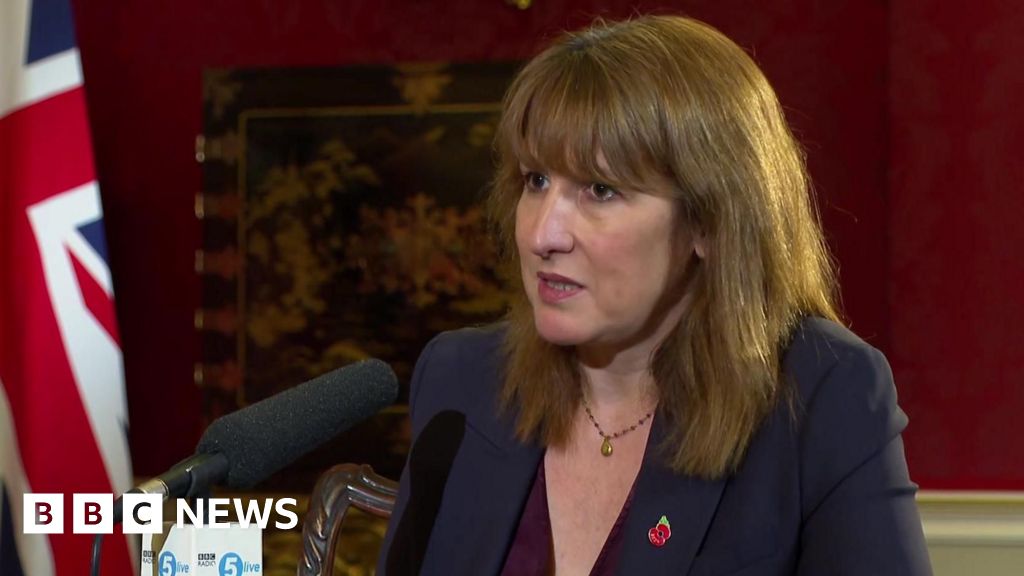
Paul SeddonPolitical reporter
Rachel Reeves has suggested she favours removing limits on benefits linked to family size at this month’s Budget.
The chancellor told the BBC it was not right that children in bigger families were “penalised” through “no fault of their own”.
The comments are a sign she could remove the two-child limit on working-age benefits introduced under the Conservatives in 2017.
Some Labour MPs have been calling for a full reversal of the policy, amid reports she was considering paring back payments after two children instead.
In September, the Guardian reported that Treasury officials were considering a tapered approach, under which parents would receive most benefits for their first child and less for subsequent children.
Other options under consideration included limiting additional benefits to three or four children, the newspaper reported.
But speaking to Matt Chorley on BBC Radio 5 Live, Reeves suggested she did not want to see benefits limited according to family size.
“I don’t think that it’s right that a child is penalised because they are in a bigger family, through no fault of their own,” she added.
“And so we will take action on child poverty. The last Labour government proudly reduced child poverty, and we will reduce child poverty as well.”
She added there were “plenty of reasons why” parents who decided to have three or four children could see their financial circumstances change.
Manifesto pledges
Elsewhere in her interview, she all but confirmed the government plans to break Labour’s manifesto pledge at last year’s general election not to raise income tax rates, VAT or National Insurance.
“It would of course be possible to stick with the manifesto commitments. But that would require things like deep cuts in capital spending,” she added.
“What I can promise now is I will always do what I think is right for our country. Not the politically easy choice, but the things that I think are necessary to put our country on the right path,” she added.
Labour’s 2024 election manifesto pledged not to raise the basic, higher, or additional rates of income tax, or National Insurance – prompting a row last autumn when Reeves announced a hike in the contributions paid by employers.
It also promised not to raise Value Added Tax (VAT), a sales tax, although the manifesto did not specify whether this applied to the rates, or which products are subject to the charge.
The chancellor has not ruled out continuing to freeze income tax thresholds beyond the 2028 date fixed by the last government, allowing more people to be dragged into higher bands as their wages rise over time.
Pressed on whether she could have avoided tax hikes through lower public spending, she said she was “not going to apologise” for increased funding for the NHS, adding that reducing waiting lists was one of her three Budget priorities.
She also claimed that some of the spending she unveiled at June’s spending review had been pencilled in, but not properly funded, by the Tories.
‘Same choices’
The two-child cap prevents households on universal or child tax credit from receiving payments for a third or subsequent child born after April 2017.
This is different to child benefit, which is paid to families where the highest-earning parent earns less than £80,000.
Separately, there is also an overall cap on the amount of benefits working-age families can claim, which has been in place since 2013.
The Institute for Fiscal Studies think tank estimates fully reversing the two-child benefit cap could take 630,000 children out of absolute poverty, defined as households with an income below 60% median average, at a cost of £3.6bn a year.
Pressure to ditch the limit increased during the recent Labour deputy leadership contest, where successful candidate Lucy Powell and runner-up Bridget Phillipson both indicated they favoured more action on child poverty.
Reform UK is pledging to scrap the limit for working British couples if it wins power, although the Conservatives say the cap should remain in place, forcing a symbolic vote on the issue in the House of Commons in September.
Speaking after the vote, Tory leader said her party believes “those on welfare should have to make the same choices as those who aren’t,” and Labour and Reform were expecting working people to pay for “unlimited handouts”.

Business
US stocks today: Markets rise on hopes of US govt shutdown ending; Nasdaq jumps over 440 points, S&P 500 gains 1% – The Times of India

Global stock markets rose sharply on Monday as investors showed optimism amid reports that the US government shutdown could soon be resolved, after a breakthrough in the record 40-day standoff.Dow was trading up 115 points or 0.25%, reaching 47,103. Nasdaq also inched 1.95% or 448 points, to trade at 23,452 at 8:50 PM IST. S&P 500 also jumped 1% to 6,804. A group of Senate Democrats joined Republicans in a procedural vote on Sunday evening, clearing the path for a formal debate after a bipartisan deal was reached to fund government operations through January. “The more risk-on mood means it’s pretty much a sea of green on the boards,” Neil Wilson, UK Investor Strategist at Saxo told AFP. The reopening could bring much-needed clarity on US inflation and the soft labour market, both critical to the Federal Reserve’s plans for potential interest rate cuts next month. “If all goes well, some federal agencies could reopen as soon as Friday,” said David Morrison, senior analyst at Trade Nation. He noted that both investors and the Fed have been “flying blind since the beginning of October, with a near-complete absence of data.” Morrison added, “Fed Chair Jerome Powell has played down the prospect of another rate cut in December, as it is far from obvious that inflation has peaked.” Investor focus on Monday was dominated by the prospect of a government reopening, as concerns mounted over the impact on low-income households reliant on food benefits and potential disruptions to air travel ahead of Thanksgiving. “Shutdowns haven’t typically had a big bearing on the economy or on financial markets. But, this one… looked as though it might start to cause some trouble,” said analysts at Capital Economics. Optimism was further boosted by Pfizer’s reported $10 billion victory in the bidding war for biotech obesity specialist Metsera over the weekend. Wall Street opened higher following a week of losses sparked by worries that the AI investment boom had inflated tech valuations to unsustainable levels. European markets also climbed, mirroring gains in Asia. Tensions between the US and China eased further after Beijing announced a one-year suspension of “special port fees” on US vessels, coinciding with Washington’s pause on levies targeting Chinese ships. In currency and commodity markets, the dollar steadied against the euro and pound while rising against the yen. Oil prices gained slightly after last week’s decline amid concerns over supply and global demand uncertainties.
Business
Are You Applying To A Job That Doesn’t Even Exist? 1 In 4 Listings Could Be Fake In 2025

New Delhi: India’s job market is facing a growing credibility crisis with a sharp rise in ghost job postings — fake or inactive listings shared by companies with no real intent to hire. A recent report by The Economic Times (ET) reveals that such misleading advertisements have increased by nearly 25 percent year-on-year, frustrating millions of job seekers.
These postings are commonly found on LinkedIn, Naukri, Indeed, and even official company portals. While they appear to signal active hiring, many exist purely for employer branding, resume collection, or market analysis. Firms often use ghost listings to gauge salary trends, talent availability, or simply to project an image of business expansion despite frozen hiring budgets.
Responding to concerns over fake listings, LinkedIn said it remains committed to protecting users from fraudulent job activity.
“We’re focused on helping recruiters find quality candidates quickly and jobseekers find their next role on LinkedIn. We use advanced technology and expert teams to proactively remove more than 99 percent of fake accounts and scams before they’re ever reported. Our policies are clear that every job a recruiter posts on LinkedIn should be authentic and accurately represented, and all listings on LinkedIn are automatically closed after 6 months,” the company said in a statement.
Despite such safeguards, ET’s report suggests that one in five online job ads could still be inactive or misleading, particularly in IT, retail, construction, and manufacturing sectors. Only about 20 percent of these listings ever result in an actual interview or offer.
Experts advise candidates to verify listings on official company websites, check posting dates, and connect with employees or HR representatives before applying. Ghost job postings, though convenient for short-term corporate branding, erode long-term trust. Strengthening transparency and authenticity in hiring will be crucial to restoring faith in India’s digital job market.
-

 Sports1 week ago
Sports1 week agoTudor’s Juve exit means McKennie must prove himself all over again
-

 Politics1 week ago
Politics1 week agoPolitical violence kills almost 300 since Hasina’s fall: rights group
-

 Sports1 week ago
Sports1 week agoPakistani runners make their mark at Istanbul Marathon
-

 Entertainment1 week ago
Entertainment1 week agoPresident Zardari to attend Second World Summit for Social Development in Doha
-

 Politics1 week ago
Politics1 week agoIran vows to rebuild nuclear sites ‘stronger than before’
-

 Tech1 week ago
Tech1 week agoLive TV Isn’t Dead. These Are the Best Live TV Streaming Services
-

 Politics1 week ago
Politics1 week agoTwo arrested after multiple people stabbed on UK train, police say
-

 Entertainment1 week ago
Entertainment1 week agoGeorge Clooney on “Jay Kelly,” fame and family







